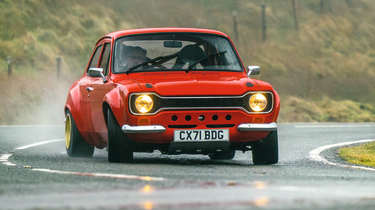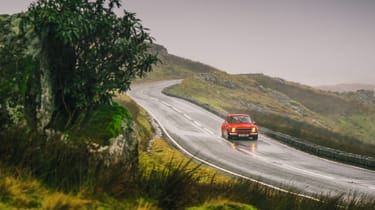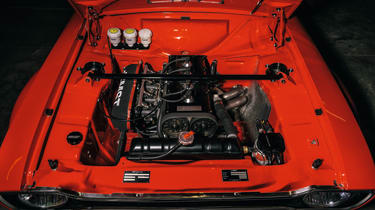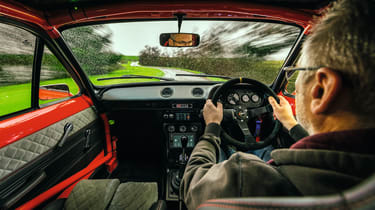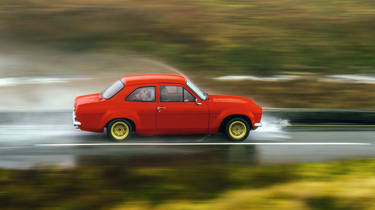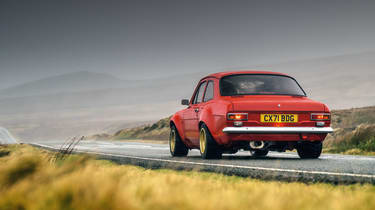MST Mk1 2024 review – £174,000 Ford Escort recreation driven
The MST Mk1 is a brand new, 50-year-old, road-going rally car. It looks the business, but does it deliver? Strap yourself in…
Finally, there’s clear road in front, a ribbon of asphalt dipping and diving across a rugged lump of rain-lashed Welsh landscape. I’m very glad to be here and, as the tacho needle climbs past 5000rpm, it feels as though the car is too, the 2-litre Cosworth BDG pulling clean and strong with a hollow bark that rally fans of all generations will recognise. And it just keeps pulling, past 7000, then 8000, with nape-prickling urgency, the sound as familiar, compelling and confident as Freddie Mercury holding a high note. Straight-line grip and traction are remarkably good, too, considering that those deep-dish 13-inch Minilites are shod with Kumho trackday tyres, and well-used ones at that. The quick-rack front end jinks the car brightly into turns and the combination of soft damping, limited-slip diff and six-link live axle keeps the back end hooked up and driving us forward.
Of course, Mk1 Escorts are famous for going sideways, and in my mind’s eye I’m already lining up a couple of corners further down this road, but gusting winds are lashing the side windows with rain and in places the road looks more like a river. Suddenly, the steering goes light and the car is understeering straight on towards the scenery. Just before the wheels touch the grass, the nose snaps back, avoiding an excursion that would be both embarrassing and expensive, because this car, which is officially not a Ford Escort, costs from £138,000. Maybe I’ll back off a bit and wait until the rain does the same.
More reviews
> Frontline LE60 v BEE GT – V8 power battles electric in MGB restomod head-to-head
This is not a Ford Escort because it has been built from scratch with brand-new parts by MST (also known as Motorsport Tools), hence the 71 plate. MST was started by Carwyn Ellis about 15 years ago and grew out of his passion for rallying, initially supplying tools. Ellis was into Escorts, so started supplying parts and then moved into building rally cars for customers. Then, about five years ago, all the parts to build a complete car became available and MST decided to go all in, investing in the jigs to construct a whole shell from new components. Then they built up a car and learned, with a bit of trial and error, how to get it through IVA (Individual Vehicle Approval). That meant they could register it as a new car.
‘The Mk2 came first. That was our mule, to prove the concept, to prove that we could get it through the IVA,’ says Ellis. To achieve approval required a collapsible steering column, a catalyst-equipped exhaust, side repeaters, no sharp edges on the interior ‘and a few other bits and bobs’. That was in 2020. ‘The minute we got that new plate on it, we posted some pictures online and it all went crazy. It just took off from there.’
They’ve now delivered five cars and have orders for another 30, mostly Mk1s. Both models incorporate all of the Group 4 motorsport mods, as many Escort rally cars would have had in period. ‘They’re all Group 4 because although most of them are road cars, people want that rally look,’ says Ellis. ‘They want a rally car on the road.
‘Usually, they had the car back in the day or their father had one, or they remember Roger Clark. So they’ve got that in their head. Now they’re a bit older, they’ve got a bit more money and they’ve decided that’s what they want.’ Escorts are surprisingly popular with the younger generation, too, says Ellis, because of the YouTube antics of Irish rallyman Frank Kelly, because the late Ken Block had one and because they’re still so big on the historic rallying scene.
Why is the Mk1 more popular? ‘There are more Mk2s out there. Mk1s are rarer and have more character,’ says Ellis. I agree. There’s a Mk2 in the workshop, also beautifully finished in solid red with 13-inch gold Minilites, but to me the Coke-bottle profiled, bubble-arch Mk1 is much better-looking and perfectly stanced. I absolutely love how it sits nice and low and how those wide Minilites – 8x13in at the front, 9x13in at the rear, shod with plump, 235/45 Kumho V700s – sit just right in the arches. Of course, MST can fit ‘two-up, two-down’ Cibié spotlights – and mudflaps the size of doormats – but this clean look is just how I’d have mine.
Ellis knows that customers who are paying £140k or more demand quality. The paint is faultless, the shutlines are crisp and tight, the chrome is shiny as newly minted silver and the doors shut with a solid thud. ‘All the mechanical stuff, it’s well developed, tried and tested in motorsport, so it’s just the refinement really – the finish, the interior trim.’
MST offers a number of drivetrain options. The Mk1 demonstrator is largely Ellis’s ideal spec, running a period-correct 2-litre BDG hooked up to an aluminium-cased, five-speed, Type 9 gearbox built by Tracsport. The BDG, evolved from the legendary BDA, is quite a pricey option at £25k. The standard-fit engine is a 2.5-litre Ford Duratec, a crate engine from the US that’s good for 200bhp and can be upgraded to 225, 250 or 270bhp. It offers a bit more torque than the BDG and comes with a Mazda MX-5 six-speed ’box, which sounds a very road-friendly combo.
At the other end of the scale is the Millington Diamond engine, evolved from the Cosworth YB from the Sierra RS Cosworth. Without a turbo, the all-aluminium 2.5-litre four delivers a potent 330bhp, or 350bhp in 2.7 spec. It can be coupled to a six-speed sequential gearbox, which is the hardcore choice and probably a bit much for the road because the dog gears require a very positive shifting style.
The Mk1 looks like a tarmac special, yet it has lots of suspension travel; among the many modifications incorporated in the shell are much roomier rear wheel-wells. Other Group 4 mods include turrets for rear coilovers (replacing separate leaf springs and dampers), box sections for the additional axle links, a wider transmission tunnel, numerous strengthening gussets and lots of seam welding. A roll-cage conforming to either current MSA or FIA historic standards can be welded in before the roof goes on. Each shell takes a pair of skilled metal workers four weeks to build, paint takes even longer and the build time for each car is around six months.
Drop into the driver’s bucket and your surroundings are familiar but different. The dash is the same shape you’d expect but leather-covered and with a cluster of bespoke dials in the usual pattern but with MST logos. There are multiple steering wheel and bucket seat choices and bespoke trim options too, this Mk1 sporting the optional leather and faux suede interior in black and grey, with diamond-stitched roof lining and luggage shelf behind the seats. It’s crafted by an ex-Bentley trimmer, no less.
Where it notably diverges from original Ford is in the centre console area. ‘The centre consoles are 3D-printed,’ says Ellis. ‘We’ve sort of kept the original design but then added our own gauges, the radio and an electric parking brake.’ The latter is another item for IVA. But fear not, for nestled between the seats there’s a traditional handbrake, hydraulic, of course.
You could be fooled into thinking that the BDG is breathing through a pair of twin-choke Webers. Turn the key and the starter churns for maybe a second longer than you expect before the engine fires and settles to a slightly edgy idle. It’s fuel-injected so the low-rev reluctance is probably down to the cams, even though these are the ‘soft’ option in BDG terms, as this is intended primarily as a fast road/trackday car.
Once you’ve got the measure of the slightly grabby, heavy-duty clutch plate, the Mk1 is happy enough to trundle along in the mostly urban traffic as we make our way from MST’s base in Pwllheli on the Llŷn Peninsula in north Wales, towards some of our favourite roads in Snowdonia. The weather is grim from the off, so I’m glad of the heated front screen, though it’s a surprise how much traction the Mk1 finds… or perhaps how little torque the BDG has. Give it a bootful below 4000rpm and not much happens, the BDG not really that interested. The 10,000rpm tacho seems to confirm this reluctance, with all of the markings up to 4000rpm crammed into the first inch of the dial. They’re generously spaced thereafter, the markings turning red at 8500rpm, though the limiter doesn’t call time until a stonking 9000.
Another reason the Mk1 doesn’t easily break traction is that it has TracTive adjustable dampers which, appropriately, are set to their softest settings, giving a supple, rounded ride. Below the Sony head unit there’s a smaller touchscreen that allows you to adjust the settings, including roll and pitch, on the fly. The damping becomes appreciably more taut as you work up through the settings, so the interface would be convenient for the regular trackday goer who doesn’t want to crawl under the car.
A feature I’m particularly impressed by is the power steering, which I’m guessing really comes into its own in the dry because those wide semi-slicks are steered through a quick rack that gives a crisp 2.4 turns lock-to-lock. An electric motor on the column combines with wheel speed sensors so that the assistance bleeds away as the speed goes up. It’s not the sharpest, most connected steering at low speed but it makes the Mk1 easy to gather if, say, you push into a small roundabout, feel the front understeer, decide to give the throttle a stab and are surprised by a sudden snap of oversteer…
When you finally get clear of town, the assistance drops and the steering picks up useful weight. The gearing feels ludicrously short in general driving, with the tacho showing 4500rpm at 60mph (in true rally-car fashion, top speed is just 120mph) but it makes more sense when you’re finally on the sort of roads the Mk1 was designed for. With the BDG keening to 7 or 8000rpm, you really feel the low kerb weight – even in all steel, the Mk1 is just 960kg. Treacherous patches of standing water apart, it feels right at home in these conditions. A little roll helps keep the wheels in touch with the road and the now nicely weighted steering gives such a positive feel and such feedback that you can press on confidently, snicking up and down the gearbox to keep the BDG on the boil. The brakes need a bit of a shove because they’re not servo-assisted, but you can lean into them with confidence and the car feels planted, poised and effective, making great progress and building your confidence.
When we finally arrive at one of the corners I’ve been looking forward to, I’m in the right gear with the revs at 6000 or so. Lift off slightly, feel the weight transfer, jab the throttle and the Mk1 assumes the attitude, back kicked out, opposite lock applied and the blaring BDG in the powerband with plenty of revs left to ride out the slide. It feels so naturally balanced, so settled and calm, you can’t help grinning. If you’ve ever watched an Escort flowing through a forest stage, on opposite lock seemingly forever, rooster tails of gravel spraying from the rear, throttle apparently stuck at about 9000rpm, a tiny homage such as this is a moment to savour.
I love this car. Is it worth upwards of £138k? An order bank of 30 cars answers that. Also, as someone who, 20-odd years ago, spent £35k building a one-off Capri with a cage, Group 4 suspension and a 300bhp engine (but a V8), for road and trackdays, I can testify that desire can override any rational notion of value for money.
For me, this MST Mk1 needs a couple of refinements. Outside you get that distinct, clear, twin-cam bark but on the inside at certain speeds there’s a bit more commotion, resonances which I guess are down to solid mountings of the drivetrain or suspension. I know it’s a rally car made with genuine rally car bits, but if it’s intended as a road car I think it should be a bit more couth. Carpets and headlining, power steering and adjustable damping don’t detract from the experience, so I’d like a bit more refinement. And decent demisting to go with the heated screens too.
I’d really like to drive it in the dry because, well, I’d really like to drive it when there isn’t a storm raging, and also because I suspect there’s almost too much grip at the back with those wide, sticky Kumhos and that maybe the sweet spot for a road car is the torquier, 270bhp Duratec. But if you want the authentic experience that the look of the MST Mk1 promises, you want the period-correct engine under the bonnet. I can still hear that BDG now.
MST Mk1 Ford Escort specs
| Engine | In-line 4-cyl, 2000cc |
| Power | 250bhp @ 9000rpm |
| Torque | 180lb ft @ 6000rpm |
| Weight | 960kg (265bhp/ton) |
| 0-62mph | N/A |
| Top speed | 120mph |
| Basic price | £174,000 (£138,000 with Duratec) |
This story first featured in evo issue 319.

